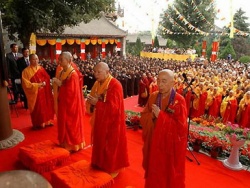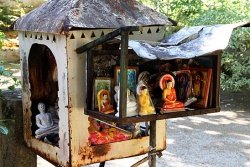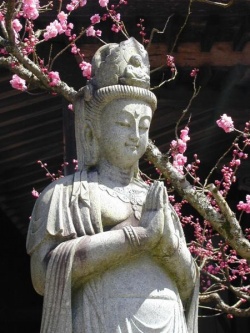Difference between revisions of "Acharya"
m (Text replacement - "Category:Pali terminology" to "{{PaliTerminology}}") |
|||
| (3 intermediate revisions by the same user not shown) | |||
| Line 1: | Line 1: | ||
[[File:Buddhist-yogi.jpeg|thumb|250px|]] | [[File:Buddhist-yogi.jpeg|thumb|250px|]] | ||
| − | In [[Indian]] [[religions]] and {{Wiki|society}}, an [[acharya]] (IAST: [[ācārya]]; [[Sanskrit]]: [[आचार्य]]; Tamil: [[அசாரி]] [[ācāri]]; [[Pali]]: [[Acariya]]) is a guide or instructor in [[religious]] matters; founder, or leader of a sect; or one who sits of [[gadi]]; or a highly learned man or a title affixed to the names of learned men. The designation has different meanings in [[Hinduism]], [[Buddhism]], [[Jainism]] and secular contexts. | + | |
| + | |||
| + | |||
| + | |||
| + | |||
| + | |||
| + | |||
| + | In [[Indian]] [[religions]] and {{Wiki|society}}, an [[acharya]] (IAST: [[ācārya]]; [[Sanskrit]]: [[आचार्य]]; [[Tamil]]: [[அசாரி]] [[ācāri]]; [[Pali]]: [[Acariya]]) is a guide or instructor in [[religious]] matters; founder, or leader of a [[sect]]; or one who sits of [[gadi]]; or a highly learned man or a title affixed to the | ||
| + | |||
| + | names of learned men. The designation has different meanings in [[Hinduism]], [[Buddhism]], [[Jainism]] and {{Wiki|secular}} contexts. | ||
[[File:Buddhism-2.jpg|thumb|250px|]] | [[File:Buddhism-2.jpg|thumb|250px|]] | ||
| − | [[Acharya]] is also used to address a [[teacher]] or a [[scholar]] in any [[discipline]], e.g.: [[Bhaskaracharya]], the {{Wiki|mathematician}}. It is also a common suffix in [[brahmin]] ([[Vishwakarma]]) names, e.g.: [[Krishnamacharya]], [[Bhattacharya]]. In {{Wiki|South India}}, this suffix is sometimes shortened to [[Achar]], e.g.: TKV Desikachar. [[Acharya]] is also used as surname. In the {{Wiki|social}} [[order]] of some parts of [[India]], acharyas are considered as the [[highest]] amongst the [[brahmin]] {{Wiki|community}}, often described as the "[[shrestha]] [[Brahman]]" i.e. best in [[brahmins]]. In Madhwa [[brahmins]] [[Acharya]] means a priestly [[person]]. | + | |
| + | |||
| + | [[Acharya]] is also used to address a [[teacher]] or a [[scholar]] in any [[discipline]], e.g.: [[Bhaskaracharya]], the {{Wiki|mathematician}}. It is also a common suffix in [[brahmin]] ([[Vishwakarma]]) names, e.g.: [[Krishnamacharya]], [[Bhattacharya]]. In {{Wiki|South India}}, this suffix is sometimes shortened to [[Achar]], e.g.: TKV Desikachar. [[Acharya]] is also used as surname. In the {{Wiki|social}} [[order]] of some | ||
| + | |||
| + | parts of [[India]], [[acharyas]] are considered as the [[highest]] amongst the [[brahmin]] {{Wiki|community}}, often described as the "[[shrestha]] [[Brahman]]" i.e. best in [[brahmins]]. In Madhwa [[brahmins]] [[Acharya]] means a priestly [[person]]. | ||
[[File:Budelter.jpg|thumb|250px|]] | [[File:Budelter.jpg|thumb|250px|]] | ||
| + | |||
| + | |||
== {{Wiki|Etymology}} == | == {{Wiki|Etymology}} == | ||
[[File:Dacien Temple91.jpg|thumb|250px|]] | [[File:Dacien Temple91.jpg|thumb|250px|]] | ||
| + | |||
| + | |||
The term "[[Acharya]]" is most often said to include the [[root]] "char" or "[[charya]]" ([[conduct]]). Thus it literally connotes "one who teaches by conduct (example)," i.e. an exemplar. | The term "[[Acharya]]" is most often said to include the [[root]] "char" or "[[charya]]" ([[conduct]]). Thus it literally connotes "one who teaches by conduct (example)," i.e. an exemplar. | ||
[[File:Daienin Kannon.JPG|thumb|250px|]] | [[File:Daienin Kannon.JPG|thumb|250px|]] | ||
== In [[Hinduism]] == | == In [[Hinduism]] == | ||
| − | In [[Hinduism]], an [[acharya]] ([[आचार्य]]) is a formal title of a [[teacher]] or [[Guru]]. In rare cases, the title may denote someone considered to be a [[mahāpuruśa]] (महापुरुश, [[divine]] [[personality]]) who is believed to have descended as an [[avatāra]] ([[अवतार]], [[incarnation]]) to teach and establish [[Bhakti]] in the [[World]] and write on the [[siddhānta]] ([[सिद्धांत]], [[Doctrine]]) of devotion to [[Bhagwan]] ([[भगवान्]], [[Lord]], [[God]], [[blessed one]], see also [[iśvara]]). | + | In [[Hinduism]], an [[acharya]] ([[आचार्य]]) is a formal title of a [[teacher]] or [[Guru]]. In rare cases, the title may denote someone considered to be a [[mahāpuruśa]] (महापुरुश, [[divine]] [[personality]]) who is believed to have descended as an [[avatāra]] ([[अवतार]], [[incarnation]]) to teach and establish [[Bhakti]] in the [[World]] and write on the [[siddhānta]] ([[सिद्धांत]], [[Doctrine]]) of [[devotion]] to [[Bhagwan]] ([[भगवान्]], [[Lord]], [[God]], [[blessed one]], see also [[iśvara]]). |
Examples of [[acharyas]] in the [[Hindu]] [[tradition]] are: | Examples of [[acharyas]] in the [[Hindu]] [[tradition]] are: | ||
| Line 21: | Line 38: | ||
* [[Caitanya Mahaprabhu]] | * [[Caitanya Mahaprabhu]] | ||
* [[Abhay Charanaravinda Bhaktivedanta Swami Prabhupada]] | * [[Abhay Charanaravinda Bhaktivedanta Swami Prabhupada]] | ||
| − | * [[Acharya]] Shree Koshalendraprasadji Maharaj – (Swaminarayan Sampraday – NarNarayan [[Dev]] Gadi) | + | * [[Acharya]] [[Shree]] Koshalendraprasadji [[Maharaj]] – (Swaminarayan Sampraday – NarNarayan [[Dev]] [[Gadi]]) |
| − | * [[Acharya]] Shree Rakeshprasadji Maharaj (Swaminarayan Sampradaya – LaxmiNarayan [[Dev]] Gadi) | + | * [[Acharya]] [[Shree]] Rakeshprasadji [[Maharaj]] (Swaminarayan [[Sampradaya]] – LaxmiNarayan [[Dev]] [[Gadi]]) |
== In [[Jainism]] == | == In [[Jainism]] == | ||
| − | In [[Jainism]], an [[acharya]] is a [[Monk]] who is one of the [[Pañca-Parameṣṭhi]] and thus [[worthy]] of {{Wiki|worship}}. An [[acharya]] is the [[highest]] leader of a [[Jain]] [[order]]. He is the final authority in his [[monastic order]] and has the authority to ordain new [[Monks]] and [[nuns]]. He is also authorized to consecrate new idols, although this authority is sometimes delegated to [[scholars]] designated by him. | + | In [[Jainism]], an [[acharya]] is a [[Monk]] who is one of the [[Pañca-Parameṣṭhi]] and thus [[worthy]] of {{Wiki|worship}}. An [[acharya]] is the [[highest]] leader of a [[Jain]] [[order]]. He is the final authority in his [[monastic order]] and has the authority to ordain new [[Monks]] and [[nuns]]. He is also authorized to [[consecrate]] new {{Wiki|idols}}, although this authority is sometimes delegated to [[scholars]] designated by him. |
| − | Some famous [[Jain]] acharyas in approximate {{Wiki|chronological}} [[order]], are: | + | Some famous [[Jain]] [[acharyas]] in approximate {{Wiki|chronological}} [[order]], are: |
| − | * [[Sudharma]] Swami | + | * [[Sudharma]] [[Swami]] |
| − | * [[Acharya]] Bhadrabahu (undivided [[Jain]] {{Wiki|community}}, [[Chandragupta]] {{Wiki|Maurya}} was his [[Disciple]]) (325 BCE) | + | * [[Acharya]] [[Bhadrabahu]] (undivided [[Jain]] {{Wiki|community}}, [[Chandragupta]] {{Wiki|Maurya}} was his [[Disciple]]) (325 BCE) |
| − | * Sthulabhadra ([[Svetambara]]) | + | * [[Sthulabhadra]] ([[Svetambara]]) |
| − | * Kundakunda ([[Digambara]], 2nd century CE) | + | * [[Kundakunda]] ([[Digambara]], 2nd century CE) |
* Jaysen [[Acharya]] ([[Digambara]]) - wrote tika on Samaysaar - i.e. commentary on Samaysaar [[Shastra]] | * Jaysen [[Acharya]] ([[Digambara]]) - wrote tika on Samaysaar - i.e. commentary on Samaysaar [[Shastra]] | ||
| − | * Amrutchandra [[Acharya]] ([[Digambara]]) - wrote a commentary called Atmakhyati on the Samaysaar [[Shastra]]. | + | * Amrutchandra [[Acharya]] ([[Digambara]]) - wrote a commentary called [[Atmakhyati]] on the Samaysaar [[Shastra]]. |
* [[Samantabhadra]] ([[Digambara]], 3rd–4th century CE) | * [[Samantabhadra]] ([[Digambara]], 3rd–4th century CE) | ||
* Siddhasena [[Divakara]] (claimed by both, 5th century CE) | * Siddhasena [[Divakara]] (claimed by both, 5th century CE) | ||
* [[Haribhadra]] ([[Svetambara]]), 700–750 CE) | * [[Haribhadra]] ([[Svetambara]]), 700–750 CE) | ||
* [[Virasena]] ([[Digambara]]), 790–825 CE) | * [[Virasena]] ([[Digambara]]), 790–825 CE) | ||
| − | * Jinasena ([[Digambara]]), [[preceptor]] of the Rashtrakuta Dynasty, (800–880 CE). | + | * Jinasena ([[Digambara]]), [[preceptor]] of the [[Rashtrakuta]] [[Dynasty]], (800–880 CE). |
* Nemichandra ([[Digambara]]) | * Nemichandra ([[Digambara]]) | ||
| − | * [[Acharya]] Hemachandra ([[Svetambara]]), [[preceptor]] of Kumarapala, (1089–1172 CE) | + | * [[Acharya]] [[Hemachandra]] ([[Svetambara]]), [[preceptor]] of Kumarapala, (1089–1172 CE) |
| − | * Jagadguru Hiravijaya ([[Svetambara]]), who was invited by Akbar, the Mughal [[emperor]] | + | * [[Jagadguru]] Hiravijaya ([[Svetambara]]), who was invited by Akbar, the [[Mughal]] [[emperor]] |
| − | * Rajendrasuri ([[Svetambara]], 1827–1906) | + | * [[Rajendrasuri]] ([[Svetambara]], 1827–1906) |
* Shantisagar ([[Digambara]], 1872–1955) | * Shantisagar ([[Digambara]], 1872–1955) | ||
* Aryanandi ([[Digambara]], 20th Century) | * Aryanandi ([[Digambara]], 20th Century) | ||
| − | {{Wiki|Modern}} [[Jain]] [[acharyas]] include [[Digambara]] [[Acharya]] Vidyasagar and Vidyanand and [[Svetambara]] [[Padma]] Sagar Suri, Subodhsagar Suri, Yashodev Suri, and Jayantsain Suri. In the Svetambar [[Terapanthi]] subsect are [[Acharya]] [[Bhikshu]], [[Acharya]] Tulsi and [[Acharya]] [[Mahapragya]] and in the [[Sthanakvasi]] subsect [[Acharya]] Sushil Kumar have been the leading acharyas. | + | {{Wiki|Modern}} [[Jain]] [[acharyas]] include [[Digambara]] [[Acharya]] Vidyasagar and Vidyanand and [[Svetambara]] [[Padma]] [[Sagar]] Suri, Subodhsagar Suri, Yashodev Suri, and Jayantsain Suri. In the [[Svetambar]] [[Terapanthi]] subsect are [[Acharya]] [[Bhikshu]], [[Acharya]] Tulsi and [[Acharya]] [[Mahapragya]] and in the [[Sthanakvasi]] subsect [[Acharya]] Sushil [[Kumar]] have been the leading [[acharyas]]. |
An [[acharya]], like any other [[Jain]] [[Monk]], is expected to wander except for the {{Wiki|Chaturmas}}. Bhaṭṭārakas, who {{Wiki|head}} {{Wiki|institutions}}, are technically junior [[Monks]], and thus permitted to stay in the same place. | An [[acharya]], like any other [[Jain]] [[Monk]], is expected to wander except for the {{Wiki|Chaturmas}}. Bhaṭṭārakas, who {{Wiki|head}} {{Wiki|institutions}}, are technically junior [[Monks]], and thus permitted to stay in the same place. | ||
| Line 55: | Line 72: | ||
In [[Buddhism]], the [[Pali]] variant ''[[Acariya]]'', lit. "[[teacher]]", is one of the two [[teachers]] of a [[novice]] [[Monk]], the other {{Wiki|being}} the [[upādhyāya]]. In [[Mahayana]] [[traditions]] the [[Epithet]] ''[[acharya]]'' was more widely used as an honorific indicating great {{Wiki|scholastic}} renown; it was somewhat more {{Wiki|general}} than the similar [[Epithet]] ''[[pandita (Buddhism)|paṇḍita]]''. The [[Tibetan]] term ''[[loppön]]'' is used to translate [[acharya]]. | In [[Buddhism]], the [[Pali]] variant ''[[Acariya]]'', lit. "[[teacher]]", is one of the two [[teachers]] of a [[novice]] [[Monk]], the other {{Wiki|being}} the [[upādhyāya]]. In [[Mahayana]] [[traditions]] the [[Epithet]] ''[[acharya]]'' was more widely used as an honorific indicating great {{Wiki|scholastic}} renown; it was somewhat more {{Wiki|general}} than the similar [[Epithet]] ''[[pandita (Buddhism)|paṇḍita]]''. The [[Tibetan]] term ''[[loppön]]'' is used to translate [[acharya]]. | ||
| − | In [[Japanese]] [[Esoteric Buddhism]], the term is used for initiates: the [[Japanese]] [[Shingon]] sects employ the [[acharya]] title with its qualified {{Wiki|priests}} who have completed training at Mount Koya, while for the [[Tendai]] sect it refers to training at [[Mount Hiei]]. | + | In [[Japanese]] [[Esoteric Buddhism]], the term is used for [[initiates]]: the [[Japanese]] [[Shingon]] sects employ the [[acharya]] title with its qualified {{Wiki|priests}} who have completed {{Wiki|training}} at [[Mount Koya]], while for the [[Tendai]] [[sect]] it refers to {{Wiki|training}} at [[Mount Hiei]]. |
| + | |||
| + | |||
| + | [[slob dpon]] - [[Master]], [[acharya]]. title given to [[spiritual teachers]] and learned [[scholars]] [RY] | ||
| + | |||
| + | [[slob dpon]] - [[acharya]] 1) an accomplished [[master of meditation practice]] and study. 2) [[spiritual master]], [[acharya]], [[saint]], [[scholar]], [[teacher]]. 3) An official position in a [[monastery]]. 4) a [[preceptor]]. (presiding) [[master]]; [[preceptor]] ([[monastic]]) [RY] | ||
| + | |||
| + | [[a tsa ra]] - [[grotesque monk]], jesters of great [[indian]] [[philosophers]], corruption of [[acharya]], {{Wiki|species}} of hobgoblin or specter, clowns in [[tibetan]] [[religious]] dances [JV] | ||
| + | |||
| + | ''[[a tsa rya]]'' - SK 1) [[spiritual guide]]/ [[master]]/ [[acharya]]; 2) instructor, [[professor]]; 3) doctor [IW] | ||
| + | |||
| + | |||
{{W}} | {{W}} | ||
Latest revision as of 11:11, 17 February 2024
In Indian religions and society, an acharya (IAST: ācārya; Sanskrit: आचार्य; Tamil: அசாரி ācāri; Pali: Acariya) is a guide or instructor in religious matters; founder, or leader of a sect; or one who sits of gadi; or a highly learned man or a title affixed to the
names of learned men. The designation has different meanings in Hinduism, Buddhism, Jainism and secular contexts.
Acharya is also used to address a teacher or a scholar in any discipline, e.g.: Bhaskaracharya, the mathematician. It is also a common suffix in brahmin (Vishwakarma) names, e.g.: Krishnamacharya, Bhattacharya. In South India, this suffix is sometimes shortened to Achar, e.g.: TKV Desikachar. Acharya is also used as surname. In the social order of some
parts of India, acharyas are considered as the highest amongst the brahmin community, often described as the "shrestha Brahman" i.e. best in brahmins. In Madhwa brahmins Acharya means a priestly person.
Etymology
The term "Acharya" is most often said to include the root "char" or "charya" (conduct). Thus it literally connotes "one who teaches by conduct (example)," i.e. an exemplar.
In Hinduism
In Hinduism, an acharya (आचार्य) is a formal title of a teacher or Guru. In rare cases, the title may denote someone considered to be a mahāpuruśa (महापुरुश, divine personality) who is believed to have descended as an avatāra (अवतार, incarnation) to teach and establish Bhakti in the World and write on the siddhānta (सिद्धांत, Doctrine) of devotion to Bhagwan (भगवान्, Lord, God, blessed one, see also iśvara).
Examples of acharyas in the Hindu tradition are:
- Adi Sankaracharya
- Ramanujacharya
- Madhvacharya
- Nimbarkacharya
- Vallabhacharya
- Caitanya Mahaprabhu
- Abhay Charanaravinda Bhaktivedanta Swami Prabhupada
- Acharya Shree Koshalendraprasadji Maharaj – (Swaminarayan Sampraday – NarNarayan Dev Gadi)
- Acharya Shree Rakeshprasadji Maharaj (Swaminarayan Sampradaya – LaxmiNarayan Dev Gadi)
In Jainism
In Jainism, an acharya is a Monk who is one of the Pañca-Parameṣṭhi and thus worthy of worship. An acharya is the highest leader of a Jain order. He is the final authority in his monastic order and has the authority to ordain new Monks and nuns. He is also authorized to consecrate new idols, although this authority is sometimes delegated to scholars designated by him.
Some famous Jain acharyas in approximate chronological order, are:
- Sudharma Swami
- Acharya Bhadrabahu (undivided Jain community, Chandragupta Maurya was his Disciple) (325 BCE)
- Sthulabhadra (Svetambara)
- Kundakunda (Digambara, 2nd century CE)
- Jaysen Acharya (Digambara) - wrote tika on Samaysaar - i.e. commentary on Samaysaar Shastra
- Amrutchandra Acharya (Digambara) - wrote a commentary called Atmakhyati on the Samaysaar Shastra.
- Samantabhadra (Digambara, 3rd–4th century CE)
- Siddhasena Divakara (claimed by both, 5th century CE)
- Haribhadra (Svetambara), 700–750 CE)
- Virasena (Digambara), 790–825 CE)
- Jinasena (Digambara), preceptor of the Rashtrakuta Dynasty, (800–880 CE).
- Nemichandra (Digambara)
- Acharya Hemachandra (Svetambara), preceptor of Kumarapala, (1089–1172 CE)
- Jagadguru Hiravijaya (Svetambara), who was invited by Akbar, the Mughal emperor
- Rajendrasuri (Svetambara, 1827–1906)
- Shantisagar (Digambara, 1872–1955)
- Aryanandi (Digambara, 20th Century)
Modern Jain acharyas include Digambara Acharya Vidyasagar and Vidyanand and Svetambara Padma Sagar Suri, Subodhsagar Suri, Yashodev Suri, and Jayantsain Suri. In the Svetambar Terapanthi subsect are Acharya Bhikshu, Acharya Tulsi and Acharya Mahapragya and in the Sthanakvasi subsect Acharya Sushil Kumar have been the leading acharyas.
An acharya, like any other Jain Monk, is expected to wander except for the Chaturmas. Bhaṭṭārakas, who head institutions, are technically junior Monks, and thus permitted to stay in the same place.
In Buddhism
In Buddhism, the Pali variant Acariya, lit. "teacher", is one of the two teachers of a novice Monk, the other being the upādhyāya. In Mahayana traditions the Epithet acharya was more widely used as an honorific indicating great scholastic renown; it was somewhat more general than the similar Epithet paṇḍita. The Tibetan term loppön is used to translate acharya.
In Japanese Esoteric Buddhism, the term is used for initiates: the Japanese Shingon sects employ the acharya title with its qualified priests who have completed training at Mount Koya, while for the Tendai sect it refers to training at Mount Hiei.
slob dpon - Master, acharya. title given to spiritual teachers and learned scholars [RY]
slob dpon - acharya 1) an accomplished master of meditation practice and study. 2) spiritual master, acharya, saint, scholar, teacher. 3) An official position in a monastery. 4) a preceptor. (presiding) master; preceptor (monastic) [RY]
a tsa ra - grotesque monk, jesters of great indian philosophers, corruption of acharya, species of hobgoblin or specter, clowns in tibetan religious dances [JV]
a tsa rya - SK 1) spiritual guide/ master/ acharya; 2) instructor, professor; 3) doctor [IW]




